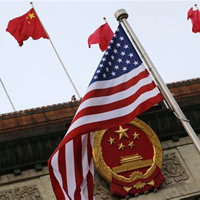- 当前位置:
- 首页>
- 活动>
- ������������
������������
CCG持续关注国际关系议题,推动中国与全球化的发展,积极开展国际交流,充分发挥智库“二轨外交”作用,在巴黎和平论坛、达沃斯世界经济论坛、慕尼黑安全会议等重要国际政策与意见交流平台上组织分论坛、边会、圆桌会议、晚宴等活动,促进国际政商学界对话,凝聚共识;CCG积极与各国政界、智库界、工商界开展“二轨外交”活动,每年常态化赴多国调研与交流,促进中外关系攸关方互动,保持与多国政策圈层的沟通渠道。
-
储殷:平台售卖金额产品不能逃避法律责任
储殷,全球化智库(CCG)研究员,国际关系学院教授
2018年7月12日 -
胡永泰:从美国三大担忧化解中美贸易战
胡永泰,CCG学术委员会专家、美国加州大学戴维斯分校经济系教授中美贸易战背后是美国的三个担忧:中国正“偷走”美国工作,中国要求技术转让导致美国高薪工作流失,中国威胁美国国家安全。 近期,中美贸易摩擦加剧了中美关系的紧张。美国宣布计划对数千种中国产品征收额外关税,第一批价值340亿美元的商品从7月6日开始面临25%的关税。中国政府此前表示,如果美方实施征税措施,中方将被迫进行反制。 在此前夕,全球化智库(CCG)特邀美国加州大学戴维斯分校经济系教授、CCG学术委员会专家胡永泰在CCG进行学术交流,他分别从中美两国视角分析了中美贸易关系紧张的深层次原因,阐述了相关问题处理不当的后果,并针对性地指出了中美两国化解贸易战的应对选项。以下是胡永泰教授的发言内容精编。从“战略合作伙伴”到“战略竞争对手” 过去,美国时任总统克林顿一直坚持与中国实行接触政策,并称之为“战略合作伙伴”。然而在2000年,当时还是总统候选人的小布什否认了“合作伙伴”的标签,他称中国为“战略竞争对手”。至此之后的每一年,我都会在圣诞节到来时松一口气:所幸在过去的12个月里,中美贸易战未曾发生。但过几天我又会感到恐惧,因为导致中美紧张局势的因素实际上仍未得到充分解决。对于中美双方来说,“合作伙伴”和“竞争对手”两种关系实际上是共存的。小布什当选总统初期,美国稳固其世界地位需要中国的支持,而911事件过后,中美合作也有效稳定了中美双边关系。但现在,特朗普竞选成功后,“竞争对手”的言论则占了上风,导致中美紧张关系日益严峻。而不断升级的中美贸易战背后其实是二十一世纪美国对中国日渐加剧的三个担忧:中国正在“偷走”美国工作,因中国要求技术转让而导致美国高薪工作流失,以及人们所感知到的中国对美国国家安全的威胁。“人民币升值”并非中美贸易失衡的真正解决方案 第一个担忧——美国就业问题被认为是中国贸易顺差的副产品,而美方主张通过人民币升值的办法来补救。美国方面认为,目前中国占美国贸易逆差总额的15%,同时又通过外币储蓄干预人民币汇率,最终导致贸易逆差问题越来越严峻,美国国内就业机会流向海外。因此,“人民币升值”成为了共和党呼吁解决贸易失衡问题时响亮的口号,犹如彼得森国际研究所的“合唱团之歌”。 然而,这种想法是错误的:汇率只是造成贸易不平衡的其中一个因素,任何人民币升值都不可能改变多级世界的现状。举例来说,20世纪80年代初,美国财政赤字剧增,对外贸易逆差大幅增长。1985年实施广场协议后(Plaza Accord),日元升值,美国减少从日本的进口,但同时,从其他国家购买了很多,最后导致美国的整体贸易逆差还是基本保持不变。除此之外,值得一提的是,这种观点背后的两种汇率理论,即莫里斯?戈斯坦德计算法和购买力平价计算法(PPP,Purchasing Power Parity),都不能合理地算出实际汇率。因为要看人民币多大程度被低估,需要知道汇率均衡。根据均衡价格即等于市场清算价格的定义,前者错误假设了中国的经常账户为负,后者则通常会高估实际汇率且与市场清算价格无关。 实际上,中美贸易失衡源于中美两国社会和经济体系的结构性缺陷。对于中国来说,不充分的社会安全网络提高了储蓄率,而同时功能失调的金融系统未能将多余的储蓄引向国内投资。另一方面,美国高昂的军费开支和频繁的减税政策也为结构性的贸易逆差创造了条件,而就业保障的不足和低效更使人们对美国贸易逆差的意见越来越大。然而,推动人民币升值不仅不能解决美国在全球的贸易逆差问题,还会对中国产生负面影响。同时,也会转移中美政策制定者的注意力,使其忽略了真正有效的解决方案:纠正中美经济体系中的结构性要素的缺陷。因此,要想解决贸易顺逆差问题,中美双方都需要做出努力,而不是一味地把注意力集中在汇率提升上面。技术转移政策引发美国企业不满/中国需减少利用市场力量加速技术赶超的行为 推动中国和美国走向贸易战的第二个问题是技术竞争。美国企业抱怨中国利用自身的市场规模,将技术转移作为外商合资企业进入其大型市场的条件。若这些美国企业不同意,中国将转向其他同样拥有前沿技术的外资企业,而当美国公司同意时,他们的产品通常会获得高额垄断价格。因此,这是一个商业上“愿买愿卖”的交易,就像沃尔玛从其供应商获得“批量折扣”一样。然而现在美国公司对中国的抱怨主要是放弃了技术秘密后,实际上他们的产品却因中国依靠市场力量(market power)在以更低的价格在中国市场出售,而且更重要的是,近几年,中国开始寻求比过去更前沿的技术转移,这让美国企业很不情愿并要求政府作出应对。这其实与国际理论中“最优关税”的概念极为相似,但是为何没有看多更多这样的现象呢?因为在国际社会缺乏反垄断机制的情况下,利益受损国家会进行报复。实际上,当这个国家无力还手时,它会同意在价格上打折,但如果它有能力,它会联合其他国家采取报复行动,那么对于双方利益都会受损,从而有市场支配地位的一方就不得不停止议价要求。因此,中国对外资企业的反对之声也不应该置若罔闻。如果欧洲和日本、加拿大等G7国家国跟随了美国的脚步,开始抵制中方利用市场力量加速技术赶超的行为,结果不容乐观。因此,中国需要新的产业政策举措来实现“中国制造2025”计划,如加强技术发展,在高校设立研究中心等。 目前中国仍被定义为发展中国家,因此正在实行的多项贸易补贴政策,如廉价土地、税收优惠和进口壁垒等,取得了WTO的许可。但是在帮助华为、百度等大型企业发展的同时,这些补贴也深化了国有企业的“软预算约束”问题,导致产能过剩、倾销、僵尸企业和鬼城等现象。因此,中国应该缩减相应的贸易补贴,以更加包容的心态对待市场中的良性竞争。世界再无霸主,多级世界中加强多边自由贸易尤为重要 第三,在国家安全方面,近年来美国深感国家安全受到威胁,这也是政府如此积极保护最前沿的知识产权的主要原因之一。随着中国在战略上的重要性日益增加,尽管中国不会成为全球霸主,美国仍然对中国的迅速崛起感到担忧。胡教授对此指出,从前英美都曾做过世界霸主,而如今,没有任何一个国家可以重现历史。虽然中国的发展势头正猛,但是印度在1984年的改革之后,开始沿着中国的发展脚步迅速赶超。随着国际秩序从美国主导的霸权时代向多极化方向发展,重叠的势力范围将深化经济和政治摩擦。因此,全球的发展繁荣需要各地区的领导者维护并加强多边自由贸易体系,这就需要合作伙伴,而合作的前提则是建立在国家安全利益之上。在如今这个阶段,中美两方同时感到威胁,双方如何建立安全感是我们需要探讨的重要问题。CFIUS指南仍需改革 在美国外国投资委员会(CFIUS)的改革指南中,提出了两点针对中美贸易关系摩擦的建议。第一,禁止向中国出口具有军事用途的高科技产品。第二,经济实力是美国国家安全的根本基础,也是中国威胁美国国家安全的基本条件。因此,应当限制与中国的企业和学术领域方面的合作。我认为,这两点建议不仅过于宽泛,无法运作,并且十分浅显和短视。因为短期看,国家安全和经济竞争从短期看可能通过“零和”来实现,但从长远来看,中美两方的经济竞争是共赢的,并且高科技领域的发展也离不开中国的竞争,而美国把这两点搞混淆了。美国:放弃“人民币升值”迷思,监督中国,改革CFIUS 那么中美两国应该如何解决此次贸易争端?对美国来说,第一,应当放弃“人民币升值”,并认识到调整美国政策内结构性因素才是解决贸易失衡的真正办法。第二,联合G7国家共同反对中国利用市场力量促进其技术发展,并监督中国使用WTO框架内的产业激励政策。第三,通过改革CFIUS,增加其有效性和可操作性,具体的措施包括:加强审查外资企业在美设立的研究中心;由破产法庭收购美资企业;明确审查范围和技术清单并持续更新等。中国:加快要素市场改革,加快提升研究发展能力,设立中国式CFIUS 与此同时,中国方面也需做出同等努力。第一,加快要素市场改革(尤其是资本市场和劳动力市场),加强社会保障网的建设。第二,从产业政策方面,减少利用市场力量获得技术的行为,并加快提升研究发展能力;缩减贸易补贴。第三,设立相应的CFIUS的审查机构,并保证运行透明。尽管中国被WTO定义为发展中国家,但它却是非洲最大的捐助国,拥有世界级制造业企业,并有能力在海外进行武装,因此中国应提升其与发达经济体的贸易和投资关系中的互惠水平。这就意味着中国需要给予更多外国企业以国民待遇,并在确保国家安全的前提下,放宽外国公司收购中国企业的限制。文章选自FT中文网,2018年7月10日
2018年7月12日 -

[China Plus] Wang Huiyao: Rationality is key to resolving the trade rift
Amidst escalating trade tensions, the US and China should maintain a calm and rational approach. At the same time, they should also prepare for negative impacts that might arise as the two sides head towards deploying tariff measures, albeit with China in a defensive position. Finding an early off-ramp to the current tensions and preventing mutual losses that will be incurred is a key test for the wisdom and ability of policymakers on both sides. The worst-case scenario is one that sees both sides keep fighting until the bitter end, potentially dragging the whole world down in the process.While the Trump administration is threatening all kinds of measures, none of these can compare to the consequences of an all-out trade war between China and the US. Together, these two countries accounted for 40 percent of the global economy and over half of global growth in 2017. One can imagine just how much damage a Sino-US “trade tsunami” could do to the entire global economy.In line with the "America First" mantra, the White House continues to fan flames of antagonism towards China, reflecting a zero-sum mindset and over-confidence. This is despite the fact that in previous negotiations, China has already committed to increasing purchases of US goods, particularly agricultural products, energy, and other high-quality products and services. The US has now totally abandoned the previous consensus reached by Beijing and Washington in May, putting the interests of both nations and other countries around the world at severe risk.Although the experiences of past trade conflicts may be forgotten by people today, we should still draw lessons from the current confrontation as it unfolds and seek a timely resolution so we can avoid even larger losses. As an old Chinese phrase reminds us, opportunities often arise from challenges and there remains leeway for adjustment as long as the US is willing to change course and steer towards a cooperative track again.Below, I would like to outline four promising areas for China and the US to work together towards goals of balanced trade, job creation and sustainable growth. These are goals that the Trump administration has committed to, and China would also benefit from this bilateral cooperation.The first area is services, which play an important role in balancing Sino-US economic relations. New WTO data show that the US ran a surplus of $54 billion in trade in services with China in 2016, a 33-fold rise over ten years prior. Given rising incomes and demand for quality services in China, there is considerable room for further growth in Sino-US trade in services, particularly in tourism, education, and cultural products.Take tourism for example, which accounts for over half of US service exports to China. A recent report by CCG found that in 2016, the number of visits to the US by Chinese tourists grew 15 percent to almost 3 million, with associated spending in the US up 9 percent to around $33 billion. Deeper bilateral cooperation on services trade will not only help reduce the trade deficit, but also increase opportunities for exchange and mutual understanding.Second, the rising spending power and evolving preferences of China’s 400 million-strong middle class present major opportunities for US exporters. Online shopping is the most striking reflection of this growing market.Spending by Chinese consumers during last year’s annual November 11 online shopping spree reached $40.5 billion in a single day, and trade via China’s cross-border e-commerce (CBEC) platforms has grown at over 50 percent annually for the last three years.Both sides can help unlock the CBEC potential to connect China’s growing market with US companies both large and small by pursuing a bilateral CBEC agreement that allows for coordination on relevant standards and trade facilitation measures. This would give Chinese consumers access to a wide range of quality products while helping reduce the trade deficit and creating opportunities for employment, innovation and investment in both countries.Third, current trends are conducive to growing energy trade between China and the US in the coming years and decades. It is only a matter of time before China surpasses the US to become the world’s largest energy consumer and imports now account for over half of China’s energy use. Beijing’s efforts to tackle air pollution and shift to cleaner fuels will drive demand for gas imports in particular.Meanwhile, the shale revolution means that the US is expected to become a net energy exporter by 2022. This represents a major shift in the global energy sector and China is the ideal market to absorb rising US exports. In 2017, China imported 220,000 barrels of crude oil per day from the US. There is potential for US energy exports to China to rise significantly in the coming years. Chinese capital can also help resolve midstream infrastructure bottlenecks in the US that currently limit the growth of energy exports.Fourth, there are many other opportunities for Sino-US collaboration in infrastructure. President Trump’s $1 trillion infrastructure initiative calls for major investment in transport networks, water supply, communications and power grids. China’s accumulated capital and infrastructure knowhow can contribute to this program.Leveraging Sino-US synergies in infrastructure cooperation will not only create jobs and help boost US exports, but can also build momentum for cooperation in other areas.US policymakers should be open-minded towards constructive suggestions, keeping their people’s interests in mind as well as the welfare of citizens around the world by avoiding the trap of zero-sum thinking and stubbornness. Lessons we can derive from our small missteps may help us to avoid making grave mistakes in future.About Author Dr. Wang Huiyao, founder and president of the Center for China and Globalization(CCG), an independent think tank based in Beijing.From China Plus,2018-7-8
2018年7月12日 -

【CRI】Wang Huiyao: Diversification is always the best strategy
The Chinese side has just unveiled new measures to offset the side effects of the trade friction with the United States. For example, to help the targeted companies, and also to encourage them to diversify import sources, especially when it come to soybeans. The CRI studio invited Wang Huiyao, president of the Center for China and Globalization (CCG), to share his opinions about the general impacts of the trade friction.From CRI,2018-7-11
2018年7月12日 -
王辉耀:被利用的“贸易逆差”与被忽略的服务贸易
作者简介 王辉耀全球化智库(CCG)主任 迈入7月,中美贸易争端的阴云日益笼罩全球。美国总统特朗普于当地时间6月15日宣布将对从中国进口的价值500亿美元的商品征收关税,而后于19日再指示“美国贸易代表以10%的比率将再对价值2000亿美元的中国商品征收额外的关税。”不仅针对中国,美国还对加拿大、日本、墨西哥以及欧盟使出了关税大棒,不顾“贸易战两败俱伤”的后果,意欲把全球拉进贸易战的泥潭中。此次发难,特朗普的一个重要论据就是美国对上述国家存在严重逆差。而中国作为美国最大的贸易逆差来源国,无疑会受到格外的“重视”。然而,20世纪的统计方式需要用21世纪的统计方式来反映真正的贸易价值。“中美贸易逆差巨大”这一说法就更站不住脚了。由于全球化的发展、劳动分工的不同,美方以过去的算法计算贸易顺/逆差的方式已经不适应新时代,全球价值链的分析体系才能更好的解释当前世界贸易格局的本质。全球价值链是指在全球范围内的生产活动,涵盖商品生产与服务环节,连通区域的生产、加工、销售、回收等环节的跨国性生产网络,众多参与企业通过承担不同功能,捕获不同利润,并通过与主供应商及跨国公司的协调实现该链条的持续性运作。 贸易逆差会因运算方式的不同而差异巨大,美方忽视了全球价值链的各国分工。据美方统计,2017年美中贸易逆差的总额为3752亿美元,占中美货物贸易总量的47%。而据中国海关总署统计,这一数字为2758亿美元。中美之间的贸易差主要是中美在世界市场的分工和所处的价值链位置决定的。从1989到2015年间,美国从香港、台湾和韩国的进口比从36.9%降低到了1.8%,但是同期美国从中国的进口则从11.7%上升到38.6%,美国贸易赤字没有减少,只不过贸易赤字国改变了。从全球价值链角度分析,中美贸逆差得出的结论大不相同。在全球价值链时代,某一产品的生产过程在不同的国家或地区进行,而非传统算法中全部算在出口国上。据中国科学院测算,2010-2013年,以增加值核算的中美贸易顺差,比以传统方式核算的要低48%到56%。 中国出口到美国的产品中,支付给第三国的专利、品牌等费用,没有算进中美贸易逆差之中。中国的产品长期处于全球价值链的低端位置。中国虽被誉为“世界工厂”,但却大多是劳动密集型、加工型产品,价值链的中上游则是提供品牌、技术的外国公司。据中方统计,2017年,中国货物贸易顺差的61%来自加工贸易。“世界工厂”的获利也最低,但在计算贸易顺/逆差上,却把产品所有利润的“账面”都算在中国上,这就使中国实际获利有限,但表面上有着巨大的顺差。 所谓的“贸易逆差”数据存在巨大的偏差:美国在华企业的收益并未算到美国的贸易额之中,在中国的美国子公司为其母公司的巨大收入没有算入美国的贸易额中,而是算在了中国的贸易额中,此消彼长拉大了数据;此外,中美贸易额的数据基于进出口商的地理位置,却不显示最终收入为哪国企业获得。根据美国经济分析局(BEA)的最新数据,2015年,美国公司在在中国的总销售额为3730亿美元,其中包括中国子公司的2230亿美元、美国对中国出口的1500亿美元。同样,2015年中国企业对美国的销售总额是4030亿美元,其中100亿美元通过中国在美国的子公司完成,通过出口销售3930亿美元,而这一部分却没有计算在中美贸易逆差之中。 以在中国设厂生产的苹果公司为例,根据中国海关统计,苹果公司2015年海外市场取得的1400亿美元的收益都未计入美国的出口。如果将苹果公司在大中华区获得的附加值收益计入美国的出口,那么美对大中华地区的出口就增加13.1%,双边的贸易赤字就会缩减6.7%。另外,中国的苹果公司厂家组装制造的苹果手机主要从美国、韩国和日本等国家进口半导体等零部件,大部分的利润被美国、韩国和日本等国家所获,但是最终计算贸易额时却把这一部分计算为中国所得,成为中美贸易逆差额的巨大部分。这只是苹果一家公司,如果把所有类似公司都计算在内,这一数字将更大。在特朗普宣布税改政策之后,苹果宣布将汇回海外3500亿美元收入,中国是苹果最大的海外市场,这3500亿美元里面也应该有很大一部分都被记在了中国的对美顺差的账单上了。 贸易逆差的统计中,美国统计的口径也存在问题。美国笼统地将香港等地的转口贸易部分计入中国,但实际上还有向其他经济体的贸易转口。而且,美国对出口金额按离岸价格、进口金额按到岸价格计算,将装卸、运输和保险等费用的双倍数额计入美中贸易逆差,这些都是导致贸易逆差数字“虚高”的原因。 另一个方面,美方除了“错用”计算方式之外,还“自动屏蔽”了其在服务贸易上对华的巨大顺差。所谓的“2017年美中贸易逆差的总额为3752亿美元”只包括了货物贸易,没有反映服务贸易。以旅游、留学和投资移民为代表的服务贸易也长期以来被忽略。 服务贸易增加值也由于中美在世界市场的不同分工地位,顺差向美国集中,逆差向中国集中,这也是中美在全球价值链的位置所决定——2016年,美国服务贸易顺差2506亿美元,居世界第一;中国服务贸易逆差2426亿美元,也位居世界第一。中国商务部的数据显示,过去十年间,美国服务业对华出口增长了5倍,2016年美国对华在教育、旅游、知识产权、交通、商业、金融等服务贸易上的顺差达557亿美元,占中国服务贸易逆差总额的23.1%,约为2006年的40倍。而这部分的贸易额是不被计算在中美之间的贸易额中的。而且随着中国消费能力的提升和市场的扩大,在服务领域占优势的美国的对华顺差会越来越大。 在旅游方面,旅游项目占美国对华服务出口的56%。根据美国商务部2017年8月发布的数据,2016年中国内地游客到访美国的人数达到近300万,增长了15%,消费支出330亿美元,上升了9%。在教育方面,根据美国国际教育协会(IIE)的数据,2016年中国留学生在美国的人数为32.85万人,中国在其生源国中排名第一,占美国留学生比例的31.5%。 以2016年中国留学生人均在美国年花费4.5万美元计算,中国留学生一年为美国带来了约159亿美元的收入。相比之下,来华留学的美国人只有2万。在技术移民方面,根据美国EB-5投资移民行业协会(IIUSA)的数据,2016财年,各国申请EB-5申请总数为13273件,其中,中国家庭占10948件,占比达到82.48%,中国大陆的投资人仍是申请EB-5的主力军。从以上数据可以看出,中国在留学、旅游、投资移民等方面的服务贸易都处于逆差的状态。所以,如果把中美服务贸易算进去,可以很大程度上降低中美贸易的逆差。 显然,“贸易逆差”已经成为了特朗普总统对外追求单边主义,实施所谓“美国第一”战略的最为趁手的“口实”。其貌似“正义而合理”的诉求对内可以获得民意加持,对外又可以占领道德的高地。但如果我们从一个更符合现实的评价体系角度,就可以很明白特朗普政府这种“技术操作”的硬伤。几百年前的贸易统计方式既无法解释更无法解决我们今天碰到的一系列问题。我们应该利用全球价值链的分析框架来有效分析今天的国际贸易形势,本着合作双赢而非对抗双输的态度来更好的处理当前现实中的国际经贸问题。文章选自中国日报网,2018年7月10日
2018年7月12日 -
李稻葵:贸易摩擦是美国更年期撞上中国青春期
专家简介李稻葵,全球化智库(CCG)学术委员会专家,清华大学中国与世界经济研究中心主任。 2018APEC工商领导人中国论坛7月6日在京启幕,在7月7日的论坛上,清华大学中国经济思想与实践研究院院长李稻葵说,目前的中美贸易摩擦,是美国的更年期撞上了中国的青春期。 他在会上表示,未来十年中国会有三个方面的巨大变化。 第一,未来十年中国的科技创新、科技进步会加快。“最近一系列的事情,中兴通讯,中美贸易摩擦等,都是在点醒中国人,告诉我们科技创新的重要性。” 他认为中国在科技创新发展方面是有基础的,“中国大学也许在培养经济学学者方面有些落后,但中国大学培养工程师在本科阶段一点不落后。” 他说,现在差的是体制创新,必须给科研人员应有的回报。 第二是制度的创新会加快。他坚信有几个方面的改革会加快。首先,国企改革通过这次贸易摩擦一定会加快;其次是房地产问题,“地价这么高,根本上还是体制不对,新加坡有成功的经验,可以学习。” 第三,中国与世界、与美国的关系,未来十年是重要的磨合期。他表示自己不认为中美关系现在碰到大危机了,而是要通过这个磨合期达到平衡。 他说,现在是美国的更年期遇到中国的青春期,“现在中美关系不是均衡状态,是磨合期。” 他认为,美国在中美关系上要接受两点,首先是要接受中国体制不可能和美国一样,中国不可能往回走,双方是不同的发展道路;其次要接受中国未来十年之内会成为第一大经济体,中国必须要有解决周边问题的能力。 在中美关系的磨合期,他说绝不认为美国会全面和中国撕破脸,因为双方利益交叉太大。但中国必须提防和把控两个风险。风险一,美国不是铁板一块,要注意区分;风险二,中国国内一定要控制狭隘的民族主义,以防过激,“青春期要压住火。”文章选自网易财经,2018年7月7日
2018年7月11日 -
Woo Wing Thye: How China, US can avert trade war decades in the making
Editor’s note: Woo Wing Thye is a professor of economics at the University of California, Davis, director of the East Asia Program at Columbia University, and academic advisor of the Center for China and Globalization (CCG). The article was edited from a recent speech given by Woo at a CCG seminar in Beijing.After studying US-China trade relations for the past 40 years, I believe that the current tensions between the two are such that we should not only focus on the past or the future, but also the present.The escalating US-China trade conflict is partly an outgrowth of three concerns on the American side: job losses, competition over technology and a perceived "Chinese threat" to US national security.The first concern is that Americans view losing jobs to China as a byproduct of China’s trade surpluses. To address this, the US has called for revaluation of the renminbi. Such an approach is misguided.Look back to 1985 after the implementation of the Plaza Accord, which drove up the value of the Japanese yen: the US did buy less from Japan because Japanese imports were now more expensive, but Americans simply bought more from other countries, so the overall US trade deficit remained largely unchanged. If something similar were to happen to the Chinese renminbi against the US dollar, then not much would change either.The trade imbalance between the two powers also suffers from structural flaws. Soaring military expenditures and frequent tax cuts in the US have created the economic conditions for trade deficits. Advocating for the appreciation of the renminbi as the solution to the trade imbalance only papers over the underlying problems.Boeing, a US aerospace company, reveals its first passenger-carrying hypersonic vehicle concept – and it could get you from London to New York in two hours. /VCG PhotoThe second issue pushing both countries toward a trade war is technological competition. Since the mid-1990s, China has made it a condition that foreign firms must transfer knowledge via joint ventures with Chinese partners in order to access its market.When it comes to technology, Chinese companies are essentially demanding a discount in the form of acquiring the tech so foreign companies get a share of the Chinese pie. This arrangement was fine when both sides made healthy profits, and American companies simply transferred their old technologies to their Chinese counterparts because they could afford to. But as China strives to be a global tech leader, these companies are not willing to cede their competitive advantage by giving up the latest tech.As a result, these US businesses are now trying to get the government to respond by saying that China is “forcing” them to share their technology. However, these businesses are all willing participants, and often roll out products that enjoy monopoly prices in China.This brings us to the third US concern of national security. The US fears that all these technology transfers will one day pose a threat to its interests. However, it already has ways to address this.Pedestrians are reflected in a mirror next to a screen showing the closing figures for the Hang Seng Index in the Central district in Hong Kong on July 3, 2018. /VCG PhotoFor example, the US could strengthen review processes carried out by the Committee on Foreign Investment in the United States (CFIUS), so that foreign partnerships and deals can receive even greater scrutiny, reducing the risks of technological blowback.The international order is moving away from US hegemony to a multipolar world. Global prosperity requires a multilateral free-trade system. Of course, there will be economic and political friction, but China and the US must recognize the potential pitfalls and work through their problems together instead of against each other.To start, the US must not confuse strategic competition with economic competition. Strategic competition is a zero-sum game where a winner emerges only in the wake of destruction.However, economic competition may be zero-sum in the short term – such as companies with the best goods and services rising to the top – but it creates win-win outcomes in the long run. Insulating domestic companies will not help.The current US-China trade conflict has been decades in the making. Solving the conundrum requires both sides facing their problems in a cooperative manner, and realizing that economic competition does not mean having only one winner.About Author Wing Thye Woo, CCG academic advisor, Professor at University of California at Davis.From CGTN,2018-7-7
2018年7月11日